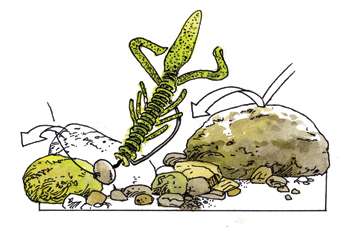
Football jigs grabbed national headlines when Bassmaster Elite Series pro Mike McClelland used a Jewel Heavy Cover football jig and Zoom Baby Brush Hog to lap the field at the 2006 installment of the Sooner Run.
The football jig again grabbed center stage in 2007 when Elite Series rookie Derek Remitz used an Omega Tackle football jig and twin-tail grub to win the season-opening Battle on the Border on Lake Amistad. Later that season, McClelland used the lure to claim victory at Georgia's Clarks Hill Lake.
By the time McClelland hoisted the champion's trophy, the football jig had taken its place as one of the premier fish-catchers in bass fishing. Both anglers employed an approach that relied on bottom contact. But, they also imparted a subtle hop or shaking motion that gave their prey a chance to look at the lure before deciding to strike it.
As more anglers added football jigs to their arsenals, these tried-and-true techniques started to dull — the bass were catching on.
But bass anglers are a crafty sort, and when they have to find ways to create strikes with existing lure categories, they often rise to the occasion. Such is the case with the venerable football jig.
BOTTOM BUGGIN'
Perhaps no one has been better known for their off-the-wall football approach than Wagoner, Okla., pro Tommy Biffle. Known for being a master of the flippin' stick in ankle-deep water, Biffle shocked the bass fishing world in 2010 with the way he won the season's final event on Fort Gibson Lake.
While victory and Biffle are not an uncommon collaboration, the theme of his latest win was unusual for the five-time B.A.S.S. winner. His prowess with a flippin' stick in shallow water would lead most in the sport to assume the 53-year-old pro was in the backwaters. The truth is, he established himself as more than versatile, and he became synonymous with the term bottom buggin'.
Bottom buggin' is a combination of lure choice and the way Biffle employs it. The approach calls for his signature Biffle HardHead Jig paired with a Biffle Bug, both manufactured by Gene Larew. The Biffle HardHead is essentially a modified football jig that combines a football head with a free-swinging offset wide gap Owner hook. When he paired it with the soft plastic Biffle Bug, he found a lure that allowed him to fish offshore quickly but gave him the hook-and-land efficiency of a jig.
"I really hate crankbaits most of the time; they lose too many fish," Biffle said. "Bottom buggin' allows me to use the bait I want, at the speed I want, and I get to throw it on a hook that I know will land most of the fish that strike it."
According to Biffle, bottom buggin' can be effective in water as shallow as 1 foot, and can be used in deep water as well. "The beauty of the technique is that I can use it anywhere," Biffle said. "It mimics a crawdad scooting away from predators by banging off the rocks, which makes bass strike out of reaction."
Biffle uses his 6-10 signature Quantum rod and heavy 20-pound-test Sunline Shooter Fluorocarbon because he retrieves the lure with his high-speed 7.0:1 Burner reel. "Because I'm using such a high-speed reel, I've figured out what head sizes to use by water depths," he said. "The trick to it is moving it quickly while keeping the bait in contact with the bottom. You do that by using the 5/16 size in less than 3 feet, the 7/16 size from 3 to 6 feet, and the 11/16 for deeper water."
He looks for flats and gently sloping points that have rocky features on them to throw his Bug, and he targets them from multiple angles. "I make long casts past the structure and move it quickly through the rocks," he said. "I cover the area thoroughly from several angles before moving on." He said he has had success with the approach all year, at water temperatures from the high 40s in the winter to the 90s in the summer.
He said strikes will vary from subtle to bone-jarring, but that despite all appearances, they are fairly easy to distinguish. "They will eat it from behind, and you'll feel the line go slack; or they will simply mouth it, and you will feel extra weight; or they'll crush it," he said. "Any way they bite it, hit them hard and let the hook do its job. It really is a lot of fun, and a different way to fish."
JERKIN' FOOTBALLS
Much like an angler would do with a suspending jerkbait in cold water through the prespawn, Scott Pauley and Bryan Head talk about using a football jig as a reaction strike generator. "I call it the Rogue technique for my football jig," said Pauley, a Jewel Jigs pro staffer and former Bassmaster Invitational angler. "I'll get on a long point or flat and twitch the jig forward with two or three short, aggressive twitches followed by pauses in between, much like I would with a Rogue."
Head, sales manager for Jewel Bait Co., surmised that the approach mimics a crawfish that is trying to quickly escape from an approaching bass. "You want the bait to skitter forward 3 to 6 inches with a pause in between," he said. "You do this by keeping your rod tip down and jerking the bait toward you sharply. Use short twitches of the rod to keep from overpowering the jig." He reported having his best success on pea gravel points, and he uses a twin-tail grub to maximize action.
The advantage that both anglers like with this technique is the ability to cover a lot of water quickly, and they enhance that by choosing rods to match the jig size. Both use 7-foot rods for 3/8- to 1/2-ounce models and flippin' sticks for heavier versions.
FLIPPIN' FOOTBALLS
Pauley fishes regional tournaments in the Midwest, and the football jig is a mainstay for him. He looks for off-the-wall applications. "One of my favorite things in early spring is to use a lighter, 3/8-ounce football jig and actually flip it," Pauley said. "The trick is to pair it with a full-size skirt and a bulky trailer, like NetBait's Paca Chunk or Paca Craw, to create a slow fall."
The beauty of the football jig occurs once the jig touches down. "The lure actually crawls over and around stumps and sticks better," he said. "I pitch it around the backs of the creeks and rivers and crawl it around shallow cover. That way I get the benefit of the extra-slow fall, and the slow crawl as well." He cautioned anglers to take a little more care with the lighter wire hook around cover, saying 15- to 20-pound line is best.
Head, who also fishes regional tournaments in his home state of Arkansas, said he, too, flips footballs, but he prefers them around isolated cover. "If I'm going into cover, then I prefer a flipping jig," Head said. "But, if I am flipping around isolated rocks or stumps, then a 1/2-ounce Heavy Cover football and twin-tail grub allow me to flip and crawl it around cover while avoiding snags."
WINDING FOOTBALLS
Pauley and Head report using 5/8- to 1-ounce footballs much like Biffle uses the Larew HardHead, but to them, it is more like a slow grind with a crankbait. "I use the winding approach in deep water with a slower reel," Head said. "When the fish are deep, and the crankbait is a little too aggressive, a jig reeled slowly along the bottom around structure is a nice alternative."
Both anglers said it is important to keep the lure in contact with the bottom while reeling, and that while the ultimate goal is to keep it moving, stopping the retrieve to stay in touch with the lake bed may be necessary.
SWINGIN' FOOTBALLS
Head said another pattern he likes around standing timber is to make a long cast past cover with a 3/4-ounce football jig and twin-tail trailer and let the lure fall naturally on taut line. "I make a long cast past pole timber and allow the jig to pendulum past the trees," Head explained. "I don't see a lot of crawdads swimming in the middle of the water column, but bass will eat that jig as it falls by them. It's a great technique when you know the depth fish are in around vertical cover."
Whatever the technique, Head advises anglers to be ready for any subtle difference in the feel of the lure. "It's important to be ready for anything," Head reported. "Anytime your jig feels different, it's time to set the hook."
While the football jig has been one of the steadiest producers for years, these three anglers show that keeping an open mind about new ways to fish old standards can produce results when tried-and-true methods fail. Keep that in mind, and maybe you, too, can produce results with your own off-the-wall football approach.
ROCK 'N' TUBE
Pauley revealed that he has been experimenting with Jewel's new football-shaped Carolina rig sinker known as The Rock for his tubes. "I've always like tubes, but jigheads are prone to snagging, and Texas rigs with bullet weights limit action," Pauley said. "I started experimenting with The Rock a couple of months ago, and it has allowed me to use a heavy, wide gap hook, but still get the advantages of the jighead action."
Pauley said he can fish it in more places because of the sinker. "The Rock allows me to hop the tube around rockpiles and laydowns, but because it separates from the tube on the fall like a sliding sinker does, it gives me the spiraling fall of a jighead," Pauley explained. "Because I use a heavy, wide gap hook, I can use heavier line and get a good, solid hook set when I get bit."
TRAILER ALTERNATIVES
Like many anglers, Scott Pauley and Bryan Head are aficionados of the standard twin-tail soft plastic grub, and they find that they use the grub much of the time. While the double curled-tail option is their norm, there are times that they choose alternative trailers.
Cold water requires a trailer that has less action, and Pauley was very specific about his choice. "I use a Sweet Beaver in cold water because it doesn't wiggle on the fall, and sluggish bass will not be put off by it," he said. "I tend to use it in water that is 50 degrees and colder."
Before and after the spawn, both anglers incorporate trailers that trigger the aggressive nature of hungry springtime bass. "I mix the Paca Chunk or Paca Craw in a lot around the spawn," Head reported. "The flapping action seems to generate the angry response I'm looking for."
In summer, both anglers revealed that there are times they can't throw baits that are too bulky, and the trailer they turn to is a full-size Brush Hog. "Bass are slaves to their metabolism in warm water," Pauley explained. "The Brush Hog provides a lot of size that gets their attention when they are looking for a big meal."





